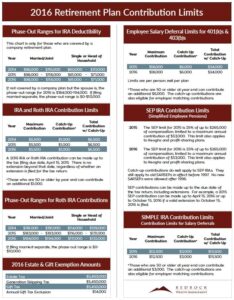
We’re about half way through 2016 – time flies! It’s important to remember with each year that passes you’ve either taken advantage of a savings opportunity or you’ve let it expire. Don’t let the last half of the year slip away without funding your retirement plan!
To help plan your finances for Q3 and Q4 of 2016, you need to understand what your savings options are. Here are some rules of thumb for your IRA, Roth IRA, and 401k retirement plan savings.
What are my retirement plan options?
Most workers today have access to a retirement plan at work. There are several types of plans depending on what type of employer you work for. Most commonly workers have access to:
- 401k plan – An IRS qualified company sponsored retirement plan which allows pre-tax contributions and possibly allows after-tax Roth contributions.
- 457 plan – A non-qualified retirement plan offered by governmental (and some non-governmental) employers.
- 403b plan – A retirement plan offered by public educational and other non-profit employers which may be qualified but is not required to be.
Most workers – but not all – have access to a retirement plan through work. For those who do not your retirement savings options may be limited to individual retirement accounts.
Retirement savings without a workplace sponsored plan
If you aren’t fortunate enough to have access to a company sponsored retirement plan, the next best thing is an individual retirement account (IRA). There are two basic IRA options:
- Pre-tax IRA. Your contribution can be deducted from your taxes when you file. Your savings grow tax-deferred and you’ll pay ordinary income tax on amounts withdrawn provided you’re over age 59 and 1/2.
- Roth IRA. Your contribution cannot be deducted from your taxes. Your savings will grow tax-deferred and you won’t pay taxes on withdrawals provided you wait until age 59 and 1/2 and you’ve held the account for 5 years or more.
Generally if you’re in higher tax brackets the pre-tax IRA option is best. If you’re in lower tax brackets the Roth IRA option will work out better in the long run. If you’re at all on the fence, pay the taxes now and fund your Roth!
Tax rates are at relatively historic lows. With so much government debt it’s likely tax rates won’t go any lower. It’s also likely tax rates may rise, so paying your taxes now and having a tax free retirement later makes a great deal of sense!
How much can you contribute to your retirement plan?
Here’s a great cheat sheet of retirement plan contribution limits for 2016. Whatever you do, make sure you’re saving as much as possible before it’s too late!
Now that you have the basics it’s time to get busy saving! Plan your finances accordingly, because it’s either an opportunity gained or an opportunity lost!

